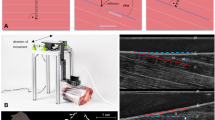Abstract
Purpose
This study aimed to use the multiscale blob feature (MBF) method to quantitatively evaluate porcine striated muscle injuries.
Methods
A porcine striated muscle injury model was induced by microwave ablation and anhydrous acetic acid injection, respectively. Then, both 2D sonographic and histological features of the lesions were recorded and compared. Later, MBF was used to quantitatively evaluate the porcine striated muscle injuries by extracting the texture features from the 2D ultrasonogram via measuring eight textural parameters (Mean, SDev, NOB, \( \overline{\text{IRGL}} \), \(\overline {\text{SOB}}\), HOD, DOD, and POD).
Results
Microwave ablation produced oval or round-like lesions, which had a pale gray color, with an echo attenuation detected at lesion center due to carbonization; anhydrous acetic acid injection produced long, stripped lesions, which had a slate-gray color, with a gas-like intense echo at lesion center. There were significant differences in Mean, \( \overline{\text{IRGL}} \) and POD between the muscle samples treated by microwave ablation and the control samples, as well as significant differences in NOB, \( \overline{\text{SOB}} \) and POD between the muscle samples treated by anhydrous acetic acid injection and the control. There were significant differences in Mean, \( \overline{\text{IRGL}} \), NOB, and \( \overline{\text{SOB}} \) between the muscle samples treated by microwave ablation and those treated by anhydrous acetic acid injection.
Conclusion
Quantitative evaluation of striated muscle injuries using the MBF method was able to differentiate the muscle injuries caused by microwave ablation and anhydrous acetic acid injection, suggesting that this method may be a potential and reliable tool for quantitative evaluation of muscle injuries.





Similar content being viewed by others
References
Junge A, Langevoort G, Pipe A, et al. Injuries in team sport tournaments during the 2004 Olympic Games. Am J Sports Med. 2006;34:565–76.
Baoge L, Van den Steen E, Rimbaut S, et al. Treatment of skeletal muscle injury: a review. ISRN Orthop. 2012;26:689012.
Campbell SE, Adler R, Sofka CM. Ultrasound of muscle abnormalities. Ultrasound Q. 2005;21:87–94.
Woodhouse JB, McNally EG. Ultrasound of skeletal muscle injury: an update. Semin Ultrasound CT MR. 2011;32:91–100.
Woodhouse JB, McNally EG, editors. Ultrasound of skeletal muscle injury: an update. Seminars in ultrasound, CT and MRI. Elsevier; 2011.
Heckmatt J, Pier N, Dubowitz V. Real-time ultrasound imaging of muscles. Muscle Nerve. 1988;11:56–65.
Heckmatt J, Dubowitz V, Leeman S. Detection of pathological change in dystrophic muscle with B-scan ultrasound imaging. Lancet. 1980;315:1389–90.
Pillen S, van Keimpema M, Nievelstein RA, et al. Skeletal muscle ultrasonography: visual versus quantitative evaluation. Ultrasound Med Biol. 2006;32:1315–21.
Scholten R, Pillen S, Verrips A, et al. Quantitative ultrasonography of skeletal muscles in children: normal values. Muscle Nerve. 2003;27:693–8.
Koh ES, McNally EG. Ultrasound of skeletal muscle injury. Semin Musculoskelet Radiol. 2007;11:162–73.
Heckmatt JZ, Leeman S, Dubowitz V. Ultrasound imaging in the diagnosis of muscle disease. J Pediatr. 1982;101:656–60.
Xu Q, Chen YQ, editors. Multiscale blob features for gray scale, rotation and spatial scale invariant texture classification. 18th international conference on pattern recognition, ICPR 2006. IEEE; 2006.
Xu Q, Wu H, Chen YQ. Statistical multiscale blob features for classifying and retrieving image texture from large-scale databases. J Electron Imaging. 2010;19:043006.
Moradi M, Abolmaesumi P, Mousavi P. Tissue typing using ultrasound RF time series: experiments with animal tissue samples. Med Phys. 2010;37:4401–13.
Ohno T, Kawano K, Sasaki A, et al. Expansion of an ablated site and induction of apoptosis after microwave coagulation therapy in rat liver. J Hepatobiliary Pancreat Surg. 2001;8:360–6.
Jain AK, Farrokhnia F, editors. Unsupervised texture segmentation using Gabor filters. In: Proceedings of IEEE international conference on systems, man and cybernetics. IEEE; 1990.
Chen YQ, Nixon MS, Thomas DW. Statistical geometrical features for texture classification. Pattern Recogn. 1995;28:537–52.
Acknowledgments
The authors wish to acknowledge Dr. Qi Xu (Department of Computer Science, Institute of Information Engineering, Shanghai Maritime University, Shanghai 200003, China) and Professor Yanqiu Chen (School of Computer Science, Fudan University, Shanghai, China) for performing the quantitative muscular texture analysis. Special thanks for the financial support from Special Project for Military Medicine of Second Military Medical University (Grant No. 2010JS13) and for Youth subject funded by Changzheng Hospital, Second Military Medical University (2012CZQN11). We appreciate the valuable comments from other members of our department.
Author information
Authors and Affiliations
Corresponding authors
Ethics declarations
Conflict of interest
The authors declared no conflict of interest.
Ethical considerations
All institutional and national guidelines for the care and use of laboratory animals were followed.
About this article
Cite this article
Zhao, J., Zhang, J., Xu, Q. et al. Quantitative evaluation of striated muscle injury by multiscale blob features method. J Med Ultrasonics 43, 337–345 (2016). https://doi.org/10.1007/s10396-016-0708-y
Received:
Accepted:
Published:
Issue Date:
DOI: https://doi.org/10.1007/s10396-016-0708-y




